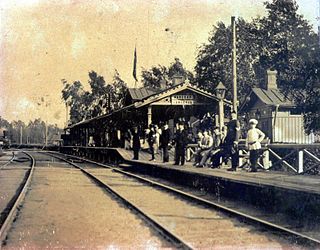
Mikhail Aleksandrovich Stakhovich was a Russian politician.

Sokol was a planned high speed train in Russia. It was to be a successor of the ER200 for use on the Moscow–St. Petersburg mainline, and was designed to operate at a cruising speed of 250 km/h. A prototype was built in 2000 and tested by Russian High Speed Railway Shareholding Co.
A train simulator is a computer based simulation of rail transport operations. They are generally large complicated software packages modeling a 3D virtual reality world implemented both as commercial trainers, and consumer computer game software with 'play modes' which lets the user interact by stepping inside the virtual world. Because of the near view modeling, often at speed, train simulator software is generally far more complicated and difficult software to write and implement than flight simulator programs.
KOI (КОИ) is a family of several code pages for the Cyrillic script. The name stands for Kod Obmena Informatsiey which means "Code for Information Interchange".

St Petersburg–Finlyandsky, is a railway station in St. Petersburg, Russia, handling transport to northern destinations including Helsinki and Vyborg.

Russian Railways is a Russian fully state-owned vertically integrated railway company, both managing infrastructure and operating freight and passenger train services.

Lanskaya platform is a railway station located in St. Petersburg, Russia.
Electrification of Saint Petersburg Railway Division. Direct lines from Saint Petersburg Finlyandsky-Vyborg and Saint Petersburg Finlyandsky-Beloostrov through Sestroretsk continued to work with steam haulage after the Russian Revolution up to World War II.

The Lansky substation was the first electrical substation constructed on the Finlyandsky Rail direct of Saint Peterburg, Russia. It is located within Lanskaya station.
Konstantin Konstantinovich Khrenov was a Soviet engineer and inventor who in 1932 introduced underwater welding and cutting of metals. For this method, extensively used by the Soviet Navy during World War II, Khrenov was awarded the State Stalin Prize in 1946.

The Ministry of Communications of the Union of Soviet Socialist Republics (USSR) was the central state administration body on communications in the Soviet Union from 1923 to 1991. During its existence it had three names: People's Commissariat for Posts and Telegraphs (1923–32), People's Commissariat for Communications (1932–46) and Ministry of Communications (1946–1991). It had authority over the postal, telegraph and telephone communications as well as public radio, technical means of radio and television broadcasting, and the distribution of periodicals in the country.

The EP10 (ЭП10) is a type of dual voltage six axle electric locomotive built for Russian railways RŽD by NEVZ in association with Adtranz/Bombardier for passenger use. The design was considered costly, and only 12 units were acquired.

ED4 is a series of Russian electric trainsets, in production since 1996. The trains are produced by DMZ and currently in service on RZD lines in almost every part of the country and former USSR states.
Alexander Petrovich Kotsubinsky is a prominent Russian psychiatrist, a spokesman of St. Petersburg psychiatric school.

The JŽ class 412/416 is an electric multiple unit built for Yugoslav Railways. The units are now used by Serbian Railways, Macedonian Railways and Montenegro Railways.

The bibliography of Fyodor Dostoyevsky comprises novels, novellas, short stories, essays and other literary works. Raised by a literate family, Dostoyevsky discovered literature at an early age, beginning when his mother introduced the Bible to him. Nannies near the hospitals—in the grounds of which he was raised—introduced Dostoyevsky to fairy tales, legends and sagas. His mother's subscription to the Library of Reading gave him access to the leading contemporary Russian and non-Russian literature. After his mother's death, Dostoyevsky moved from a boarding school to a military academy and despite the resulting lack of money, he was captivated by literature until his death.
Jolon Mamytov (Kyrgyz: Жолон Мамытов was a famous Kyrgyz aqyn, known especially for his love songs/poems. He was born in the village of Tölöykön in Kara-Suu District, Osh oblast, Kyrgyz SSR and died in Bishkek.
"An Enigmatic Nature" is an 1883 short story by Anton Chekhov.
"A Story Without a Title" is an 1888 short story by Anton Chekhov.
















